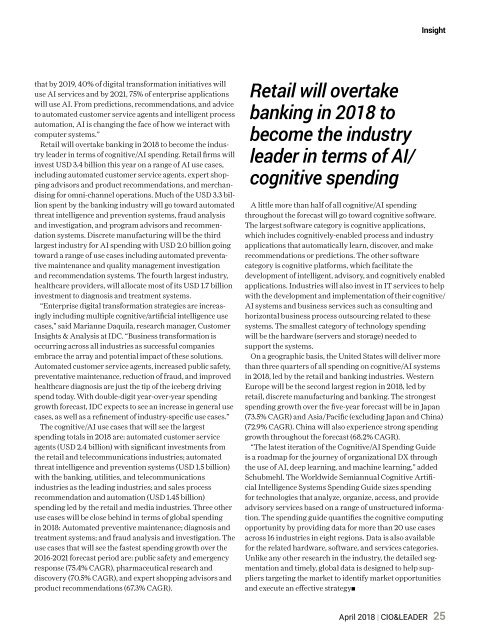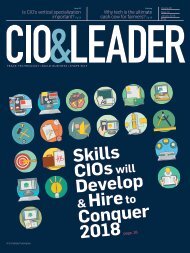CIO & LEADER-Issue-01-April 2018 (1)
Create successful ePaper yourself
Turn your PDF publications into a flip-book with our unique Google optimized e-Paper software.
Insight<br />
that by 2<strong>01</strong>9, 40% of digital transformation initiatives will<br />
use AI services and by 2021, 75% of enterprise applications<br />
will use AI. From predictions, recommendations, and advice<br />
to automated customer service agents and intelligent process<br />
automation, AI is changing the face of how we interact with<br />
computer systems.”<br />
Retail will overtake banking in 2<strong>01</strong>8 to become the industry<br />
leader in terms of cognitive/AI spending. Retail firms will<br />
invest USD 3.4 billion this year on a range of AI use cases,<br />
including automated customer service agents, expert shopping<br />
advisors and product recommendations, and merchandising<br />
for omni-channel operations. Much of the USD 3.3 billion<br />
spent by the banking industry will go toward automated<br />
threat intelligence and prevention systems, fraud analysis<br />
and investigation, and program advisors and recommendation<br />
systems. Discrete manufacturing will be the third<br />
largest industry for AI spending with USD 2.0 billion going<br />
toward a range of use cases including automated preventative<br />
maintenance and quality management investigation<br />
and recommendation systems. The fourth largest industry,<br />
healthcare providers, will allocate most of its USD 1.7 billion<br />
investment to diagnosis and treatment systems.<br />
“Enterprise digital transformation strategies are increasingly<br />
including multiple cognitive/artificial intelligence use<br />
cases,” said Marianne Daquila, research manager, Customer<br />
Insights & Analysis at IDC. “Business transformation is<br />
occurring across all industries as successful companies<br />
embrace the array and potential impact of these solutions.<br />
Automated customer service agents, increased public safety,<br />
preventative maintenance, reduction of fraud, and improved<br />
healthcare diagnosis are just the tip of the iceberg driving<br />
spend today. With double-digit year-over-year spending<br />
growth forecast, IDC expects to see an increase in general use<br />
cases, as well as a refinement of industry-specific use cases.”<br />
The cognitive/AI use cases that will see the largest<br />
spending totals in 2<strong>01</strong>8 are: automated customer service<br />
agents (USD 2.4 billion) with significant investments from<br />
the retail and telecommunications industries; automated<br />
threat intelligence and prevention systems (USD 1.5 billion)<br />
with the banking, utilities, and telecommunications<br />
industries as the leading industries; and sales process<br />
recommendation and automation (USD 1.45 billion)<br />
spending led by the retail and media industries. Three other<br />
use cases will be close behind in terms of global spending<br />
in 2<strong>01</strong>8: Automated preventive maintenance; diagnosis and<br />
treatment systems; and fraud analysis and investigation. The<br />
use cases that will see the fastest spending growth over the<br />
2<strong>01</strong>6-2021 forecast period are: public safety and emergency<br />
response (75.4% CAGR), pharmaceutical research and<br />
discovery (70.5% CAGR), and expert shopping advisors and<br />
product recommendations (67.3% CAGR).<br />
Retail will overtake<br />
banking in 2<strong>01</strong>8 to<br />
become the industry<br />
leader in terms of AI/<br />
cognitive spending<br />
A little more than half of all cognitive/AI spending<br />
throughout the forecast will go toward cognitive software.<br />
The largest software category is cognitive applications,<br />
which includes cognitively-enabled process and industry<br />
applications that automatically learn, discover, and make<br />
recommendations or predictions. The other software<br />
category is cognitive platforms, which facilitate the<br />
development of intelligent, advisory, and cognitively enabled<br />
applications. Industries will also invest in IT services to help<br />
with the development and implementation of their cognitive/<br />
AI systems and business services such as consulting and<br />
horizontal business process outsourcing related to these<br />
systems. The smallest category of technology spending<br />
will be the hardware (servers and storage) needed to<br />
support the systems.<br />
On a geographic basis, the United States will deliver more<br />
than three quarters of all spending on cognitive/AI systems<br />
in 2<strong>01</strong>8, led by the retail and banking industries. Western<br />
Europe will be the second largest region in 2<strong>01</strong>8, led by<br />
retail, discrete manufacturing and banking. The strongest<br />
spending growth over the five-year forecast will be in Japan<br />
(73.5% CAGR) and Asia/Pacific (excluding Japan and China)<br />
(72.9% CAGR). China will also experience strong spending<br />
growth throughout the forecast (68.2% CAGR).<br />
“The latest iteration of the Cognitive/AI Spending Guide<br />
is a roadmap for the journey of organizational DX through<br />
the use of AI, deep learning, and machine learning,” added<br />
Schubmehl. The Worldwide Semiannual Cognitive Artificial<br />
Intelligence Systems Spending Guide sizes spending<br />
for technologies that analyze, organize, access, and provide<br />
advisory services based on a range of unstructured information.<br />
The spending guide quantifies the cognitive computing<br />
opportunity by providing data for more than 20 use cases<br />
across 16 industries in eight regions. Data is also available<br />
for the related hardware, software, and services categories.<br />
Unlike any other research in the industry, the detailed segmentation<br />
and timely, global data is designed to help suppliers<br />
targeting the market to identify market opportunities<br />
and execute an effective strategy<br />
<strong>April</strong> 2<strong>01</strong>8 | <strong>CIO</strong>&<strong>LEADER</strong><br />
25














